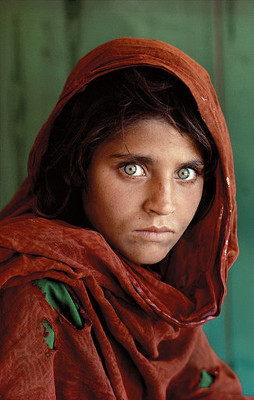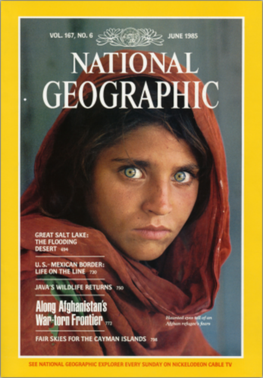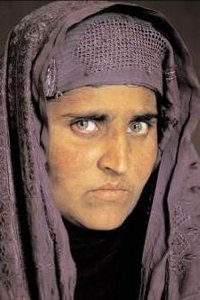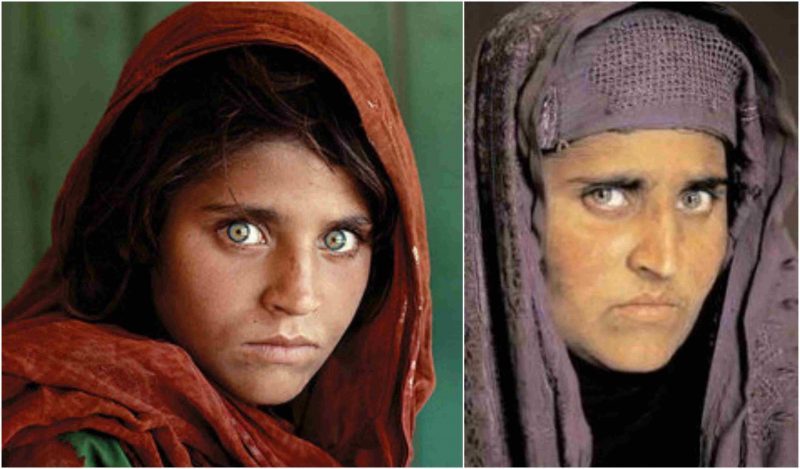The image of a young woman with green eyes in a red headscarf staring intensely at the cameras been called “the First World’s Third World Mona Lisa.” The image gave the plight of Afghani refugees a face, making their struggles very human and relatable to the otherwise detached western observer.
Became emblematic of the plight of “refugee girl/woman located in some distant camp” deserving of the compassion of the Western viewer.
Steve McCurry, National Geographic Society photographer spotted a girl with enchanting eyes among the students in an informal school in the Nasir Bagh refugee camp in 1984, it was then when he took the iconic photograph.The picture, titled Afghan Girl, appeared on the June 1985 cover of National Geographic.

The image of her face, with a red scarf draped loosely over her head and her eyes staring directly into the camera was named “the most recognized photograph” in the history of the magazine, and the cover itself is one of the most famous of the National Geographic. American Photo magazine says the image has an “unusual combination of grittiness and glamour.” McCurry made several unsuccessful attempts during the 1990s to locate her.
In January 2002, a National Geographic team traveled to Afghanistan to locate the subject. McCurry, upon learning that the Nasir Bagh refugee camp was soon to close, inquired of its remaining residents, one of whom knew Gula’s brother and was able to send word to her hometown.
However, there were a number of women who came forward and identified themselves erroneously as the famous Afghan Girl. In addition, after being shown the 1984 photo, a handful of young men erroneously identified Gula as their wife.

The team located Gula, then around the age of 30, in a remote region of Afghanistan; she had returned to her native country from the refugee camp in 1992. Her identity was confirmed by John Daugman using iris recognition. She recalled being photographed.
She had been photographed on only three occasions: in 1984 and during the search for her when a National Geographic producer took the identifying pictures that led to the reunion with Steve McCurry. She had never seen the Afghan Girl image before it was shown to her in January 2002.
Pashtun by ethnicity, Gula’s parents were killed during the Soviet Union’s bombing of Afghanistan when she was around six years old. Along with her grandmother, brother, and three sisters, she walked across the mountains to Pakistan and ended up in the Nasir Bagh refugee camp in Pakistan in 1984.
She married Rahmat Gul between the age of 13-16, and returned to her village in Afghanistan in the mid 1990s. Gula has three daughters, a fourth daughter died in infancy. She expressed hopes that her children will be able to get an education. A devout Muslim, Gula normally would wear a burka and was hesitant to meet with McCurry, as he was a male from outside the family.
When asked if she had ever felt safe, she responded “No. But life under the Taliban was better. At least there was peace and order.” Until the National Geographic team found her again, she had never seen the photo of herself as a child. When asked how she had survived, she responded that it was “the will of God”.

In 2015, local newspapers in Pakistan reported that the National Database and Registration Authority (NADRA) canceled the Computerized National Identity Card (CNIC) to Sharbat Bibi and two men listed as her sons. Reports claimed the national ID cards had been issued illegally.
A NADRA source is quoted as saying “They may not be her sons but this is a common practice among Afghan refugees whereby they list names of non-relatives as their children to obtain documents.” A relative stated that the family lives in Pakistan, but “We travel between Pakistan and Afghanistan depending on the security situation.
